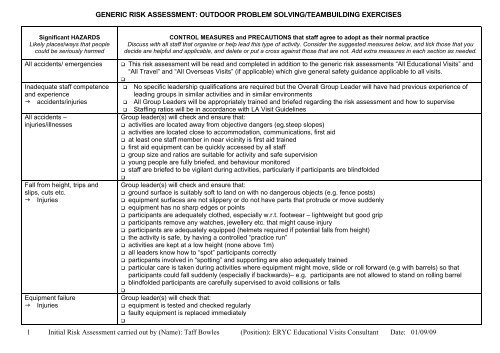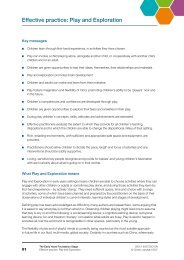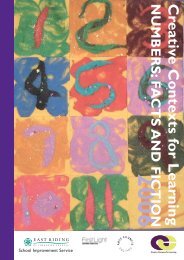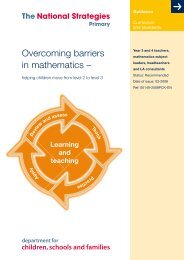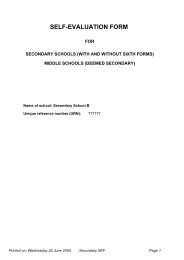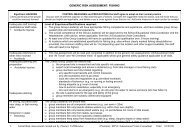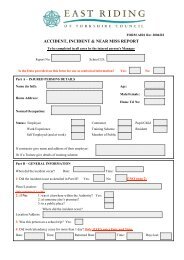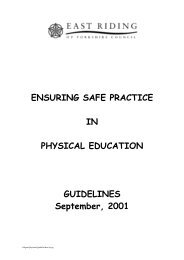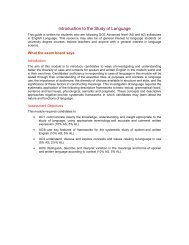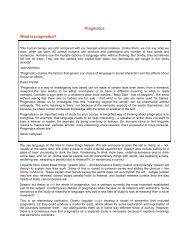Teambuilding and Problem-solving - eRiding
Teambuilding and Problem-solving - eRiding
Teambuilding and Problem-solving - eRiding
- No tags were found...
Create successful ePaper yourself
Turn your PDF publications into a flip-book with our unique Google optimized e-Paper software.
GENERIC RISK ASSESSMENT: OUTDOOR PROBLEM SOLVING/TEAMBUILDING EXERCISESSignificant HAZARDSLikely places/ways that peoplecould be seriously harmedCONTROL MEASURES <strong>and</strong> PRECAUTIONS that staff agree to adopt as their normal practiceDiscuss with all staff that organise or help lead this type of activity. Consider the suggested measures below, <strong>and</strong> tick those that youdecide are helpful <strong>and</strong> applicable, <strong>and</strong> delete or put a cross against those that are not. Add extra measures in each section as needed.All accidents/ emergenciesInadequate staff competence<strong>and</strong> experience accidents/injuriesAll accidents –injuries/illnessesFall from height, trips <strong>and</strong>slips, cuts etc. InjuriesEquipment failure Injuries This risk assessment will be read <strong>and</strong> completed in addition to the generic risk assessments “All Educational Visits” <strong>and</strong>“All Travel” <strong>and</strong> “All Overseas Visits” (if applicable) which give general safety guidance applicable to all visits.No specific leadership qualifications are required but the Overall Group Leader will have had previous experience ofleading groups in similar activities <strong>and</strong> in similar environments All Group Leaders will be appropriately trained <strong>and</strong> briefed regarding the risk assessment <strong>and</strong> how to supervise Staffing ratios will be in accordance with LA Visit GuidelinesGroup leader(s) will check <strong>and</strong> ensure that: activities are located away from objective dangers (eg.steep slopes) activities are located close to accommodation, communications, first aid at least one staff member in near vicinity is first aid trained first aid equipment can be quickly accessed by all staff group size <strong>and</strong> ratios are suitable for activity <strong>and</strong> safe supervision young people are fully briefed, <strong>and</strong> behaviour monitored staff are briefed to be vigilant during activities, particularly if participants are blindfoldedGroup leader(s) will check <strong>and</strong> ensure that: ground surface is suitably soft to l<strong>and</strong> on with no dangerous objects (e.g. fence posts) equipment surfaces are not slippery or do not have parts that protrude or move suddenly equipment has no sharp edges or points participants are adequately clothed, especially w.r.t. footwear – lightweight but good grip participants remove any watches, jewellery etc. that might cause injury participants are adequately equipped (helmets required if potential falls from height) the activity is safe, by having a controlled “practice run” activities are kept at a low height (none above 1m) all leaders know how to “spot” participants correctly particpants involved in “spotting” <strong>and</strong> supporting are also adequately trained particular care is taken during activities where equipment might move, slide or roll forward (e.g with barrels) so thatparticipants could fall suddenly (especially if backwards)– e.g. participants are not allowed to st<strong>and</strong> on rolling barrel blindfolded participants are carefully supervised to avoid collisions or fallsGroup leader(s) will check that: equipment is tested <strong>and</strong> checked regularly faulty equipment is replaced immediately1 Initial Risk Assessment carried out by (Name): Taff Bowles (Position): ERYC Educational Visits Consultant Date: 01/09/09
GENERIC RISK ASSESSMENT: OUTDOOR PROBLEM SOLVING/TEAMBUILDING EXERCISESSignificant HAZARDSLikely places/ways that peoplecould be seriously harmedHeavy equipment – lifting orfallingIllness or injury if away frombaseActivities that cross waterDeep water - drowningAdditional Hazards?CONTROL MEASURES <strong>and</strong> PRECAUTIONS that staff agree to adopt as their normal practiceDiscuss with all staff that organise or help lead this type of activity. Consider the suggested measures below, <strong>and</strong> tick those that youdecide are helpful <strong>and</strong> applicable, <strong>and</strong> delete or put a cross against those that are not. Add extra measures in each section as needed.Group leader(s) will ensure that: the need to lift heavy equipment is avoided procedures for safe lifting beforeh<strong>and</strong> are properly explained/demonstrated (staff to assist where necessary) any heavy equipment cannot fall on participants participants are briefed how to carry equipment logs/planks are carried by 2 people – one at each end to avoid hitting others when turning around if rough wood is used, gloves are issued to avoid splintersGroup leader(s) will ensure that: staff have information about any special needs/medical conditions leaders are fully briefed regarding accident/emergency procedures <strong>and</strong> contact numbersGroup leader(s) will check that: participants wear correctly sized/fitted buoyancy aids if appropriate participants wear correctly sized/helmets if appropriate a trained leader has a throwline or reaching pole available Additional precautions?2 Initial Risk Assessment carried out by (Name): Taff Bowles (Position): ERYC Educational Visits Consultant Date: 01/09/09
GENERIC RISK ASSESSMENT: OUTDOOR PROBLEM SOLVING/TEAMBUILDING EXERCISESStaff Agreement: “I have read <strong>and</strong> understood this risk assessment, <strong>and</strong> I agree to adopt as st<strong>and</strong>ard the control measures <strong>and</strong> precautions stated above”Staff name(continue list overleaf if required)1.2.3.4.5.6.7.8.9.10.11.12.13.14.15.16.17.18.19.20.Job title Sept 2009 – 10(Initials/date)Sept 2010 – 11(Initials/date)Sept 2011 – 12(Initials/date)Sept 2012 – 13(Initials/date)Sept 2013 – 14(Initials/date)Generic Risk Assessments• Purpose - to encourage staff to identify likely hazards, agree good practice, <strong>and</strong> apply consistent st<strong>and</strong>ards. Follow suggested procedure below (or similar):• Select <strong>and</strong> print off - all relevant <strong>and</strong> helpful forms (according to the type of visits <strong>and</strong> activities normally organised during the year) – others (e.g. that apply to one-off visits) can be added later if required.• How many? - one set of forms for small staff teams - or one set per department for large staff teams.• Complete draft forms - initially by one or two staff with appropriate experience;• Staff meeting 1 - introduce <strong>and</strong> leave draft forms in a file for all relevant staff (i.e. those who organise or help lead such visits) to inspect <strong>and</strong> consider over a short period (e.g. a week).• Staff meeting 2 - discuss, amend, <strong>and</strong> agree main hazards <strong>and</strong> st<strong>and</strong>ard practice with all relevant staff (add names <strong>and</strong> initials in table below to indicate acceptance).• Staff members who cannot agree with the general consensus should complete their own risk assessment, but this must be agreed <strong>and</strong> approved by the Headteacher/Manager.• Check <strong>and</strong> approve - by line manager/head of dept <strong>and</strong>/or visits coordinator (add approval signatures in table below).• Store - in a marked file in a clearly known <strong>and</strong> accessible place (e.g. staff room or dept office).• How often? - forms that apply to all visits (e.g. “All Educational Visits”) or to regular/frequent visits (e.g. “Visits to Museums” ) should be completed once, then reviewed, amended, signed <strong>and</strong> dated annually.• Additional forms - that apply to occasional/one-off visits (e.g. “Overseas Visits”) can be completed when required – these should be reviewed, amended, signed <strong>and</strong> dated whenever such visits are planned.• Keep familiar- with the agreed practice, <strong>and</strong> refer to forms as a reminder before visits if necessary (especially for activities that are less frequent or familiar to staff).• New leaders <strong>and</strong> volunteers - should be asked to read all relevant forms <strong>and</strong> add their signed agreement before assisting with the organisation or leadership of a visit.• Review <strong>and</strong> amend - by all relevant staff annually (or more often if necessary), <strong>and</strong> immediately if new hazards are identified or new precautions deemed necessary.• Stop - this type of visit/activity if the level of risk is considered unmanageable <strong>and</strong> unacceptable.• Flexibility - may be acceptable on occasion, if staff can reasonably justify their actions.• Specific Visit Risk Assessment - is also required for each visit to address any extra issues relevant to the specific site/group/activities involved.3 Initial Risk Assessment carried out by (Name): Taff Bowles (Position): ERYC Educational Visits Consultant Date: 01/09/09


